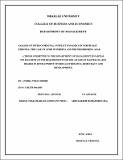| dc.description.abstract | Conflict is natural phenomena of human life. It is value free; it can be both constructive and
destructive. The problem is, thus not the existence of conflict rather the way we react to it.
The main themes of this research were to examine the dynamic inter-communal conflicts
between Atsbi wonberta and their neighboring Afar in North East Ethiopia. This research
gives emphasis to the underlying cause, dynamics and trends of the conflict by recognizing
that this requires a deep understanding of historical and current relationship of the two
communities in time of peace and conflict. To this end, both secondary and primary sources
were used. However, due to the fact that either the recent conflict is less known and much
neglected or literature on Atsbi Wonberta-Afar conflict is hardly available, secondary data
have lesser share in this research. The research methodology employed for this study was
qualitative, descriptive analysis. Atsbi Wonberta and their neighboring Afar communities
have long history of peace full socio- economic interaction. Prior to 1991, these communities
used to live peacefully. Conflicts were occurred rarely and if happened were resolved via
traditional conflict resolution mechanism called Gereb/shimgilina. But after 1991, the
relation of the two communities kept worsening and violent conflict continues to persist. The
finding of this study revealed that the causes of the conflict are related to socio-cultural and
economic variables. Government intervention in the conflict was very late and very little only
focusing on treating symptoms of the problem than addressing the root causes. The pasture
and water- related conflicts have been shown a shift with the intention of gaining territorial
extension. This exacerbated the situation and hinders the sustainability of peace.
Consequently, the conflict becomes catastrophic at one time and cools down at another time.
The persistent conflict resulted in loss of human life, property damage and violation of
people’s fundamental right and reduced development efforts in the study area. The culture of
interdependence and symbiotic relationships between the two communities like “Fukur”
(close friendship) and “Gereb” (joint institution for resolving conflict) have now fading
away. This implies the gravity of the problem. Therefore, persistent efforts are required to
bring about negotiable and non-confrontational commitment on the part of the two
communities. To this end, the study underscores the importance of timely intervention on the
part of the two wereda government. Government officials at wereda level should work hand
in hand with the local communities and support the deep-rooted local institution, Gereb, so
as to strengthening conflict prevention and management between the two communities. | en_GB |


